Effective Caring: Analyzing Quality of Life, Techniques, and Barriers
VerifiedAdded on 2023/01/05
|10
|3131
|74
Report
AI Summary
This report provides a comprehensive overview of effective caring within the healthcare sector. It begins by defining effective care and emphasizing its direct correlation with improved quality of life for patients. The report explores various factors that contribute to a good quality of life, including income, health, education, and social interactions, while also highlighting the impact of government policies. It then delves into different caring techniques, such as developing care plans, monitoring health status, building trust, observation, distraction, safe practices, and working alongside patients, while also identifying and analyzing barriers to positive care. The report further recognizes the importance of person-centered care, safeguarding vulnerable clients, and effective communication skills in enhancing patient outcomes. Finally, the report offers recommendations for improving health outcomes.
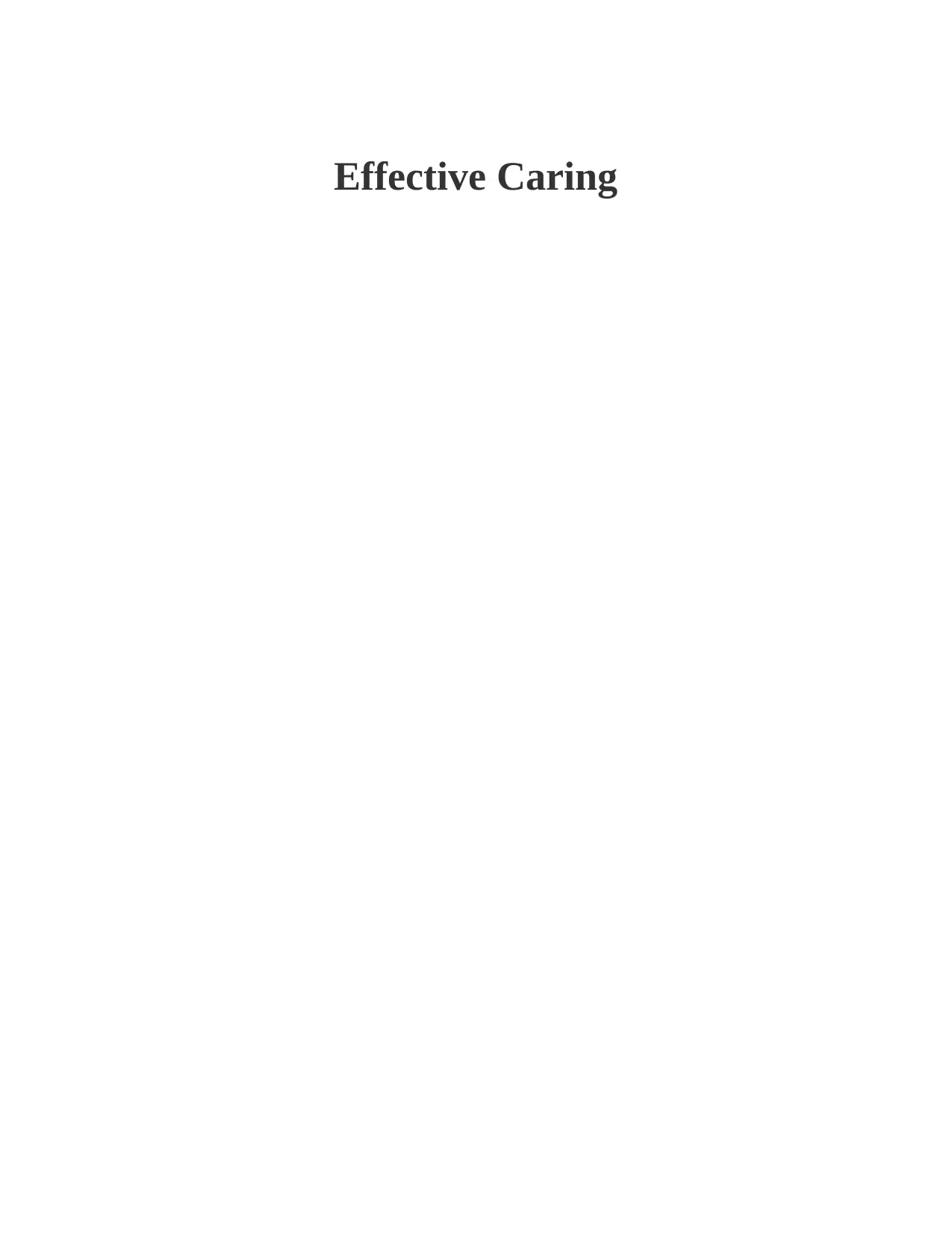
Effective Caring
Paraphrase This Document
Need a fresh take? Get an instant paraphrase of this document with our AI Paraphraser
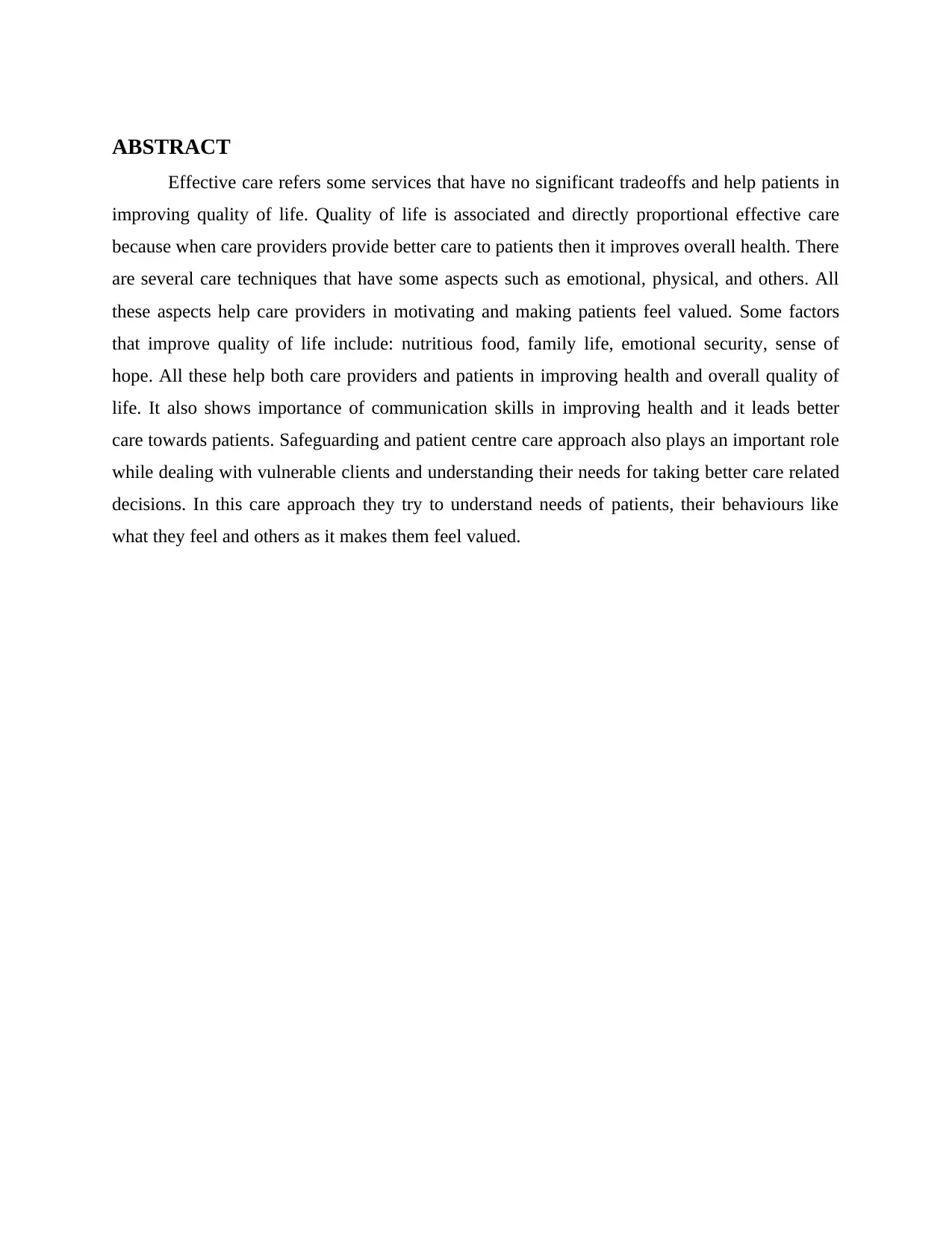
ABSTRACT
Effective care refers some services that have no significant tradeoffs and help patients in
improving quality of life. Quality of life is associated and directly proportional effective care
because when care providers provide better care to patients then it improves overall health. There
are several care techniques that have some aspects such as emotional, physical, and others. All
these aspects help care providers in motivating and making patients feel valued. Some factors
that improve quality of life include: nutritious food, family life, emotional security, sense of
hope. All these help both care providers and patients in improving health and overall quality of
life. It also shows importance of communication skills in improving health and it leads better
care towards patients. Safeguarding and patient centre care approach also plays an important role
while dealing with vulnerable clients and understanding their needs for taking better care related
decisions. In this care approach they try to understand needs of patients, their behaviours like
what they feel and others as it makes them feel valued.
Effective care refers some services that have no significant tradeoffs and help patients in
improving quality of life. Quality of life is associated and directly proportional effective care
because when care providers provide better care to patients then it improves overall health. There
are several care techniques that have some aspects such as emotional, physical, and others. All
these aspects help care providers in motivating and making patients feel valued. Some factors
that improve quality of life include: nutritious food, family life, emotional security, sense of
hope. All these help both care providers and patients in improving health and overall quality of
life. It also shows importance of communication skills in improving health and it leads better
care towards patients. Safeguarding and patient centre care approach also plays an important role
while dealing with vulnerable clients and understanding their needs for taking better care related
decisions. In this care approach they try to understand needs of patients, their behaviours like
what they feel and others as it makes them feel valued.
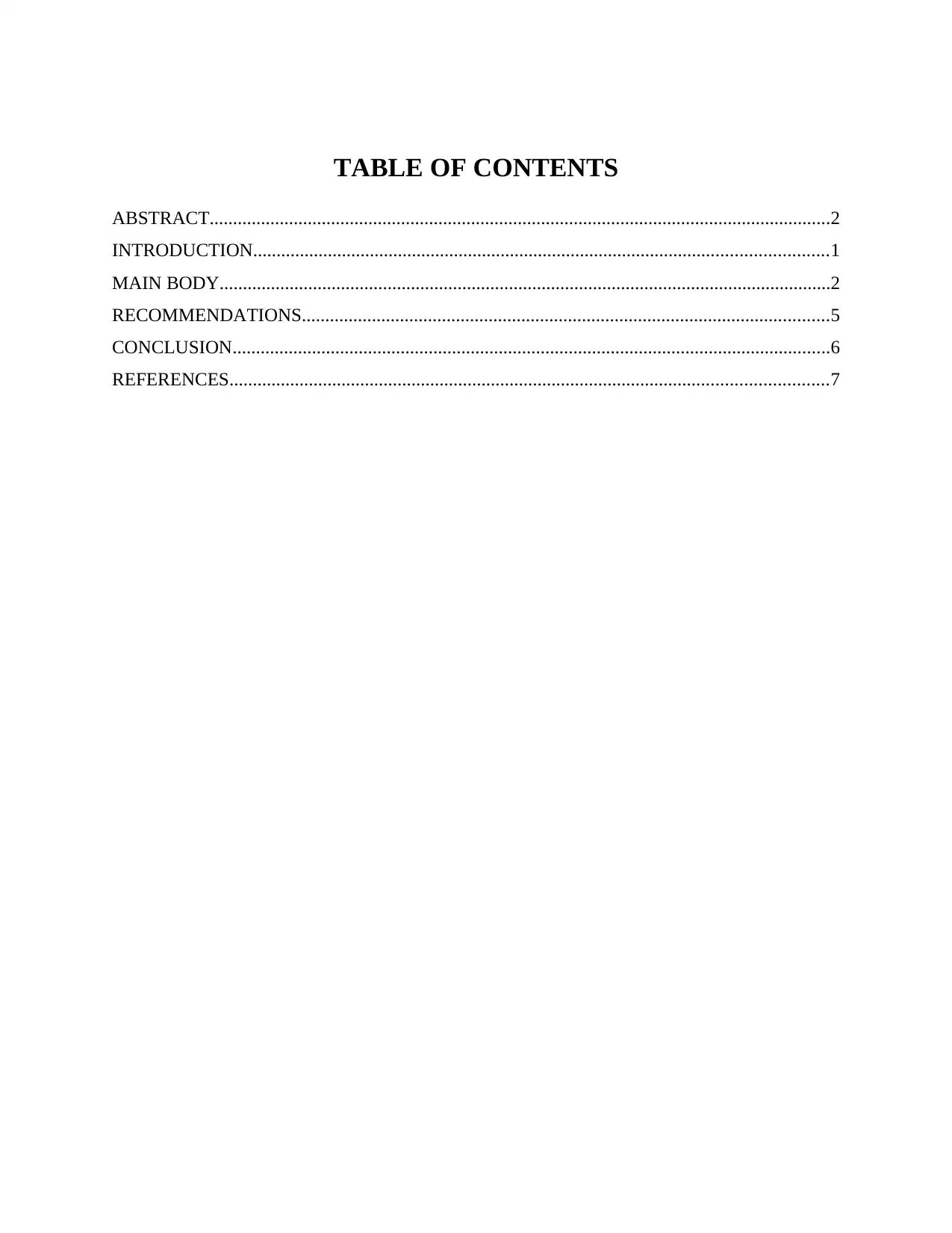
TABLE OF CONTENTS
ABSTRACT.....................................................................................................................................2
INTRODUCTION...........................................................................................................................1
MAIN BODY...................................................................................................................................2
RECOMMENDATIONS.................................................................................................................5
CONCLUSION................................................................................................................................6
REFERENCES................................................................................................................................7
ABSTRACT.....................................................................................................................................2
INTRODUCTION...........................................................................................................................1
MAIN BODY...................................................................................................................................2
RECOMMENDATIONS.................................................................................................................5
CONCLUSION................................................................................................................................6
REFERENCES................................................................................................................................7
⊘ This is a preview!⊘
Do you want full access?
Subscribe today to unlock all pages.

Trusted by 1+ million students worldwide
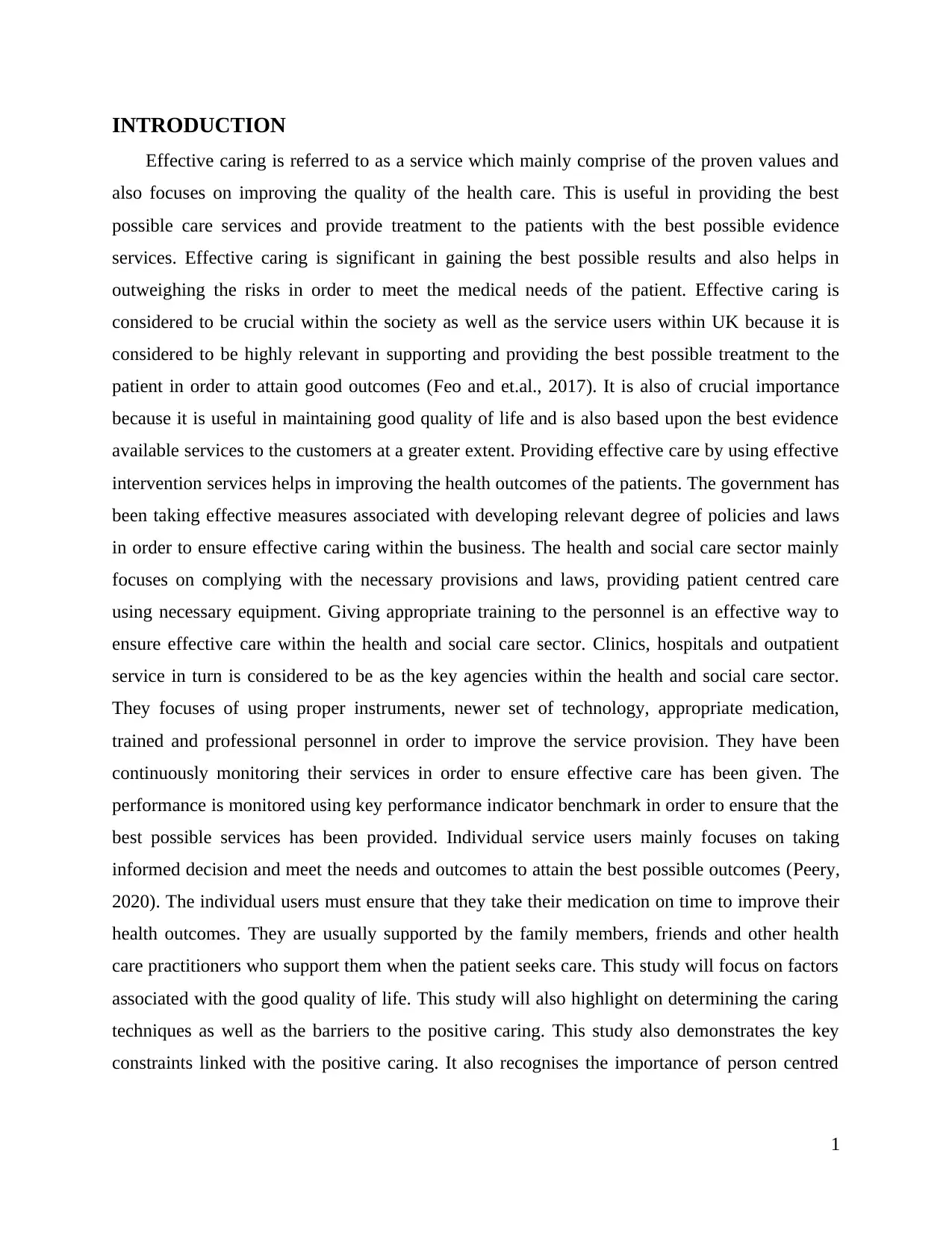
INTRODUCTION
Effective caring is referred to as a service which mainly comprise of the proven values and
also focuses on improving the quality of the health care. This is useful in providing the best
possible care services and provide treatment to the patients with the best possible evidence
services. Effective caring is significant in gaining the best possible results and also helps in
outweighing the risks in order to meet the medical needs of the patient. Effective caring is
considered to be crucial within the society as well as the service users within UK because it is
considered to be highly relevant in supporting and providing the best possible treatment to the
patient in order to attain good outcomes (Feo and et.al., 2017). It is also of crucial importance
because it is useful in maintaining good quality of life and is also based upon the best evidence
available services to the customers at a greater extent. Providing effective care by using effective
intervention services helps in improving the health outcomes of the patients. The government has
been taking effective measures associated with developing relevant degree of policies and laws
in order to ensure effective caring within the business. The health and social care sector mainly
focuses on complying with the necessary provisions and laws, providing patient centred care
using necessary equipment. Giving appropriate training to the personnel is an effective way to
ensure effective care within the health and social care sector. Clinics, hospitals and outpatient
service in turn is considered to be as the key agencies within the health and social care sector.
They focuses of using proper instruments, newer set of technology, appropriate medication,
trained and professional personnel in order to improve the service provision. They have been
continuously monitoring their services in order to ensure effective care has been given. The
performance is monitored using key performance indicator benchmark in order to ensure that the
best possible services has been provided. Individual service users mainly focuses on taking
informed decision and meet the needs and outcomes to attain the best possible outcomes (Peery,
2020). The individual users must ensure that they take their medication on time to improve their
health outcomes. They are usually supported by the family members, friends and other health
care practitioners who support them when the patient seeks care. This study will focus on factors
associated with the good quality of life. This study will also highlight on determining the caring
techniques as well as the barriers to the positive caring. This study also demonstrates the key
constraints linked with the positive caring. It also recognises the importance of person centred
1
Effective caring is referred to as a service which mainly comprise of the proven values and
also focuses on improving the quality of the health care. This is useful in providing the best
possible care services and provide treatment to the patients with the best possible evidence
services. Effective caring is significant in gaining the best possible results and also helps in
outweighing the risks in order to meet the medical needs of the patient. Effective caring is
considered to be crucial within the society as well as the service users within UK because it is
considered to be highly relevant in supporting and providing the best possible treatment to the
patient in order to attain good outcomes (Feo and et.al., 2017). It is also of crucial importance
because it is useful in maintaining good quality of life and is also based upon the best evidence
available services to the customers at a greater extent. Providing effective care by using effective
intervention services helps in improving the health outcomes of the patients. The government has
been taking effective measures associated with developing relevant degree of policies and laws
in order to ensure effective caring within the business. The health and social care sector mainly
focuses on complying with the necessary provisions and laws, providing patient centred care
using necessary equipment. Giving appropriate training to the personnel is an effective way to
ensure effective care within the health and social care sector. Clinics, hospitals and outpatient
service in turn is considered to be as the key agencies within the health and social care sector.
They focuses of using proper instruments, newer set of technology, appropriate medication,
trained and professional personnel in order to improve the service provision. They have been
continuously monitoring their services in order to ensure effective care has been given. The
performance is monitored using key performance indicator benchmark in order to ensure that the
best possible services has been provided. Individual service users mainly focuses on taking
informed decision and meet the needs and outcomes to attain the best possible outcomes (Peery,
2020). The individual users must ensure that they take their medication on time to improve their
health outcomes. They are usually supported by the family members, friends and other health
care practitioners who support them when the patient seeks care. This study will focus on factors
associated with the good quality of life. This study will also highlight on determining the caring
techniques as well as the barriers to the positive caring. This study also demonstrates the key
constraints linked with the positive caring. It also recognises the importance of person centred
1
Paraphrase This Document
Need a fresh take? Get an instant paraphrase of this document with our AI Paraphraser
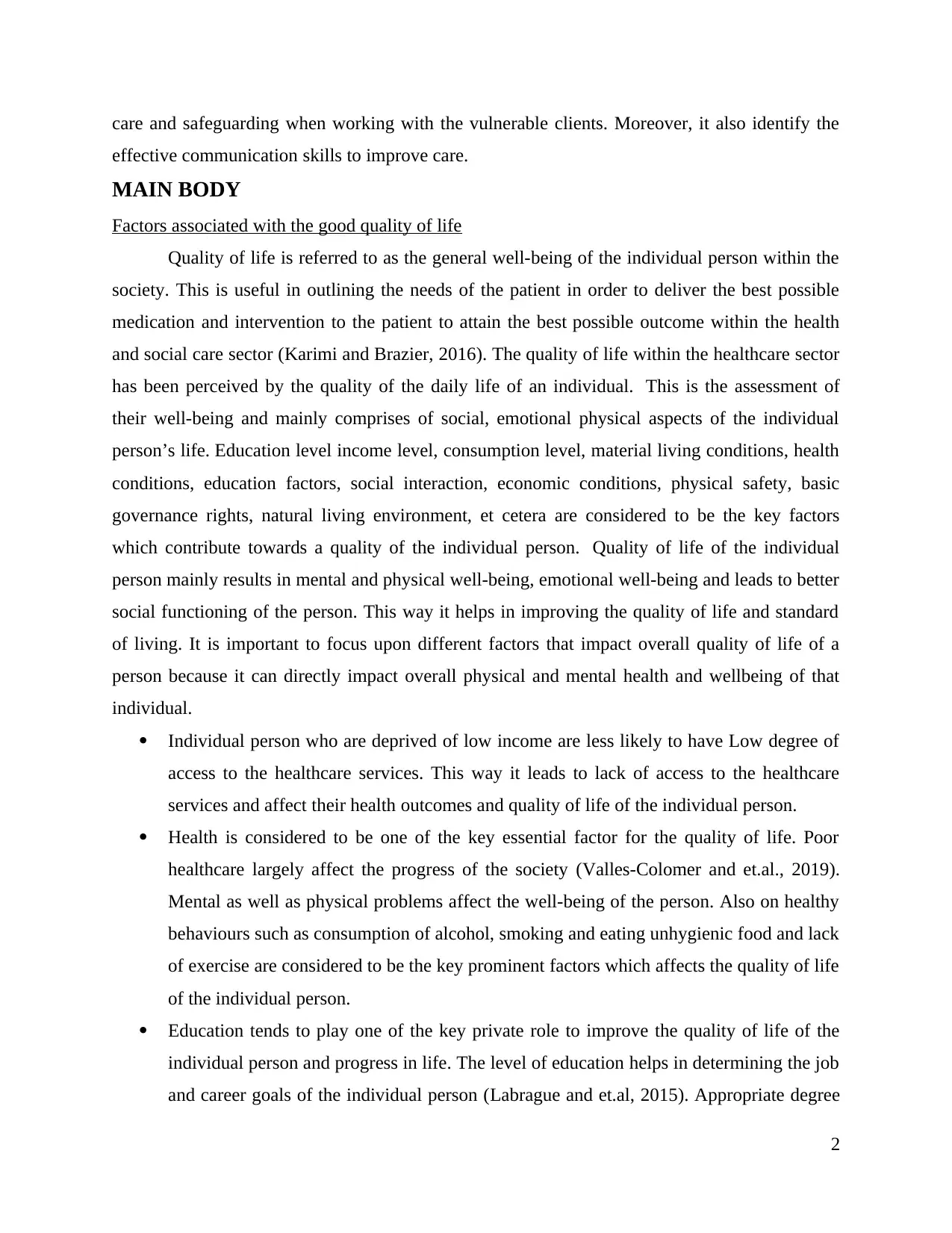
care and safeguarding when working with the vulnerable clients. Moreover, it also identify the
effective communication skills to improve care.
MAIN BODY
Factors associated with the good quality of life
Quality of life is referred to as the general well-being of the individual person within the
society. This is useful in outlining the needs of the patient in order to deliver the best possible
medication and intervention to the patient to attain the best possible outcome within the health
and social care sector (Karimi and Brazier, 2016). The quality of life within the healthcare sector
has been perceived by the quality of the daily life of an individual. This is the assessment of
their well-being and mainly comprises of social, emotional physical aspects of the individual
person’s life. Education level income level, consumption level, material living conditions, health
conditions, education factors, social interaction, economic conditions, physical safety, basic
governance rights, natural living environment, et cetera are considered to be the key factors
which contribute towards a quality of the individual person. Quality of life of the individual
person mainly results in mental and physical well-being, emotional well-being and leads to better
social functioning of the person. This way it helps in improving the quality of life and standard
of living. It is important to focus upon different factors that impact overall quality of life of a
person because it can directly impact overall physical and mental health and wellbeing of that
individual.
Individual person who are deprived of low income are less likely to have Low degree of
access to the healthcare services. This way it leads to lack of access to the healthcare
services and affect their health outcomes and quality of life of the individual person.
Health is considered to be one of the key essential factor for the quality of life. Poor
healthcare largely affect the progress of the society (Valles-Colomer and et.al., 2019).
Mental as well as physical problems affect the well-being of the person. Also on healthy
behaviours such as consumption of alcohol, smoking and eating unhygienic food and lack
of exercise are considered to be the key prominent factors which affects the quality of life
of the individual person.
Education tends to play one of the key private role to improve the quality of life of the
individual person and progress in life. The level of education helps in determining the job
and career goals of the individual person (Labrague and et.al, 2015). Appropriate degree
2
effective communication skills to improve care.
MAIN BODY
Factors associated with the good quality of life
Quality of life is referred to as the general well-being of the individual person within the
society. This is useful in outlining the needs of the patient in order to deliver the best possible
medication and intervention to the patient to attain the best possible outcome within the health
and social care sector (Karimi and Brazier, 2016). The quality of life within the healthcare sector
has been perceived by the quality of the daily life of an individual. This is the assessment of
their well-being and mainly comprises of social, emotional physical aspects of the individual
person’s life. Education level income level, consumption level, material living conditions, health
conditions, education factors, social interaction, economic conditions, physical safety, basic
governance rights, natural living environment, et cetera are considered to be the key factors
which contribute towards a quality of the individual person. Quality of life of the individual
person mainly results in mental and physical well-being, emotional well-being and leads to better
social functioning of the person. This way it helps in improving the quality of life and standard
of living. It is important to focus upon different factors that impact overall quality of life of a
person because it can directly impact overall physical and mental health and wellbeing of that
individual.
Individual person who are deprived of low income are less likely to have Low degree of
access to the healthcare services. This way it leads to lack of access to the healthcare
services and affect their health outcomes and quality of life of the individual person.
Health is considered to be one of the key essential factor for the quality of life. Poor
healthcare largely affect the progress of the society (Valles-Colomer and et.al., 2019).
Mental as well as physical problems affect the well-being of the person. Also on healthy
behaviours such as consumption of alcohol, smoking and eating unhygienic food and lack
of exercise are considered to be the key prominent factors which affects the quality of life
of the individual person.
Education tends to play one of the key private role to improve the quality of life of the
individual person and progress in life. The level of education helps in determining the job
and career goals of the individual person (Labrague and et.al, 2015). Appropriate degree
2
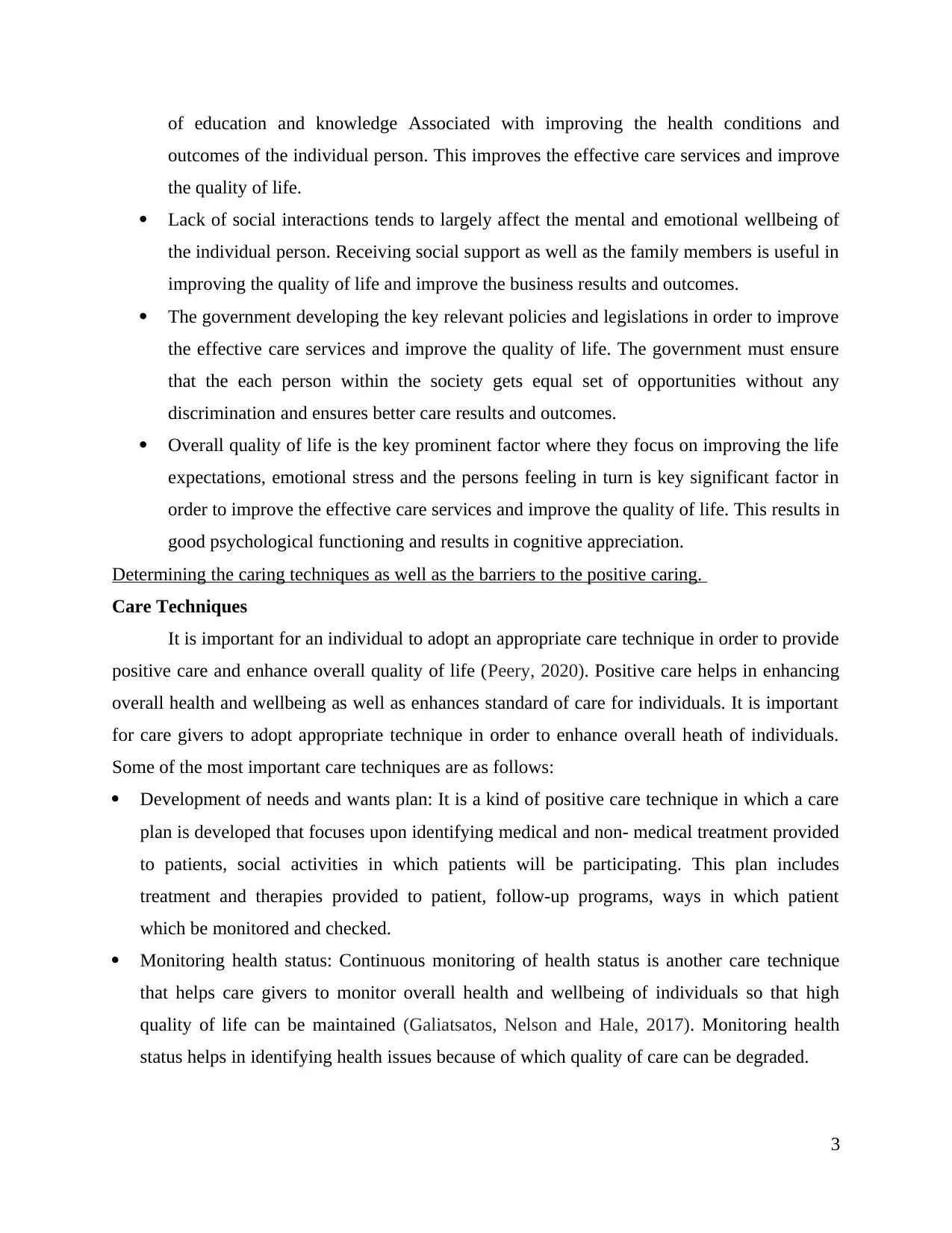
of education and knowledge Associated with improving the health conditions and
outcomes of the individual person. This improves the effective care services and improve
the quality of life.
Lack of social interactions tends to largely affect the mental and emotional wellbeing of
the individual person. Receiving social support as well as the family members is useful in
improving the quality of life and improve the business results and outcomes.
The government developing the key relevant policies and legislations in order to improve
the effective care services and improve the quality of life. The government must ensure
that the each person within the society gets equal set of opportunities without any
discrimination and ensures better care results and outcomes.
Overall quality of life is the key prominent factor where they focus on improving the life
expectations, emotional stress and the persons feeling in turn is key significant factor in
order to improve the effective care services and improve the quality of life. This results in
good psychological functioning and results in cognitive appreciation.
Determining the caring techniques as well as the barriers to the positive caring.
Care Techniques
It is important for an individual to adopt an appropriate care technique in order to provide
positive care and enhance overall quality of life (Peery, 2020). Positive care helps in enhancing
overall health and wellbeing as well as enhances standard of care for individuals. It is important
for care givers to adopt appropriate technique in order to enhance overall heath of individuals.
Some of the most important care techniques are as follows:
Development of needs and wants plan: It is a kind of positive care technique in which a care
plan is developed that focuses upon identifying medical and non- medical treatment provided
to patients, social activities in which patients will be participating. This plan includes
treatment and therapies provided to patient, follow-up programs, ways in which patient
which be monitored and checked.
Monitoring health status: Continuous monitoring of health status is another care technique
that helps care givers to monitor overall health and wellbeing of individuals so that high
quality of life can be maintained (Galiatsatos, Nelson and Hale, 2017). Monitoring health
status helps in identifying health issues because of which quality of care can be degraded.
3
outcomes of the individual person. This improves the effective care services and improve
the quality of life.
Lack of social interactions tends to largely affect the mental and emotional wellbeing of
the individual person. Receiving social support as well as the family members is useful in
improving the quality of life and improve the business results and outcomes.
The government developing the key relevant policies and legislations in order to improve
the effective care services and improve the quality of life. The government must ensure
that the each person within the society gets equal set of opportunities without any
discrimination and ensures better care results and outcomes.
Overall quality of life is the key prominent factor where they focus on improving the life
expectations, emotional stress and the persons feeling in turn is key significant factor in
order to improve the effective care services and improve the quality of life. This results in
good psychological functioning and results in cognitive appreciation.
Determining the caring techniques as well as the barriers to the positive caring.
Care Techniques
It is important for an individual to adopt an appropriate care technique in order to provide
positive care and enhance overall quality of life (Peery, 2020). Positive care helps in enhancing
overall health and wellbeing as well as enhances standard of care for individuals. It is important
for care givers to adopt appropriate technique in order to enhance overall heath of individuals.
Some of the most important care techniques are as follows:
Development of needs and wants plan: It is a kind of positive care technique in which a care
plan is developed that focuses upon identifying medical and non- medical treatment provided
to patients, social activities in which patients will be participating. This plan includes
treatment and therapies provided to patient, follow-up programs, ways in which patient
which be monitored and checked.
Monitoring health status: Continuous monitoring of health status is another care technique
that helps care givers to monitor overall health and wellbeing of individuals so that high
quality of life can be maintained (Galiatsatos, Nelson and Hale, 2017). Monitoring health
status helps in identifying health issues because of which quality of care can be degraded.
3
⊘ This is a preview!⊘
Do you want full access?
Subscribe today to unlock all pages.

Trusted by 1+ million students worldwide
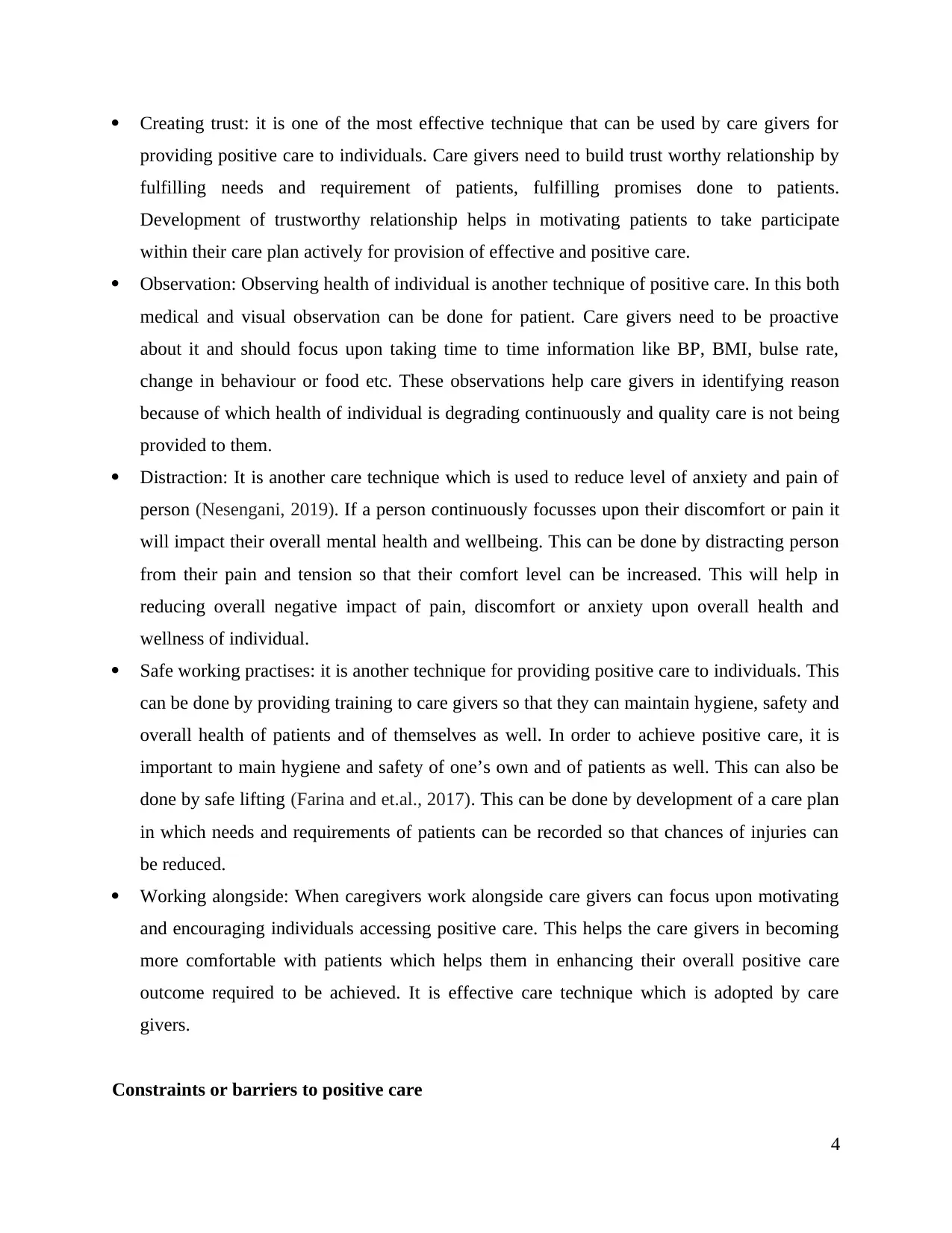
Creating trust: it is one of the most effective technique that can be used by care givers for
providing positive care to individuals. Care givers need to build trust worthy relationship by
fulfilling needs and requirement of patients, fulfilling promises done to patients.
Development of trustworthy relationship helps in motivating patients to take participate
within their care plan actively for provision of effective and positive care.
Observation: Observing health of individual is another technique of positive care. In this both
medical and visual observation can be done for patient. Care givers need to be proactive
about it and should focus upon taking time to time information like BP, BMI, bulse rate,
change in behaviour or food etc. These observations help care givers in identifying reason
because of which health of individual is degrading continuously and quality care is not being
provided to them.
Distraction: It is another care technique which is used to reduce level of anxiety and pain of
person (Nesengani, 2019). If a person continuously focusses upon their discomfort or pain it
will impact their overall mental health and wellbeing. This can be done by distracting person
from their pain and tension so that their comfort level can be increased. This will help in
reducing overall negative impact of pain, discomfort or anxiety upon overall health and
wellness of individual.
Safe working practises: it is another technique for providing positive care to individuals. This
can be done by providing training to care givers so that they can maintain hygiene, safety and
overall health of patients and of themselves as well. In order to achieve positive care, it is
important to main hygiene and safety of one’s own and of patients as well. This can also be
done by safe lifting (Farina and et.al., 2017). This can be done by development of a care plan
in which needs and requirements of patients can be recorded so that chances of injuries can
be reduced.
Working alongside: When caregivers work alongside care givers can focus upon motivating
and encouraging individuals accessing positive care. This helps the care givers in becoming
more comfortable with patients which helps them in enhancing their overall positive care
outcome required to be achieved. It is effective care technique which is adopted by care
givers.
Constraints or barriers to positive care
4
providing positive care to individuals. Care givers need to build trust worthy relationship by
fulfilling needs and requirement of patients, fulfilling promises done to patients.
Development of trustworthy relationship helps in motivating patients to take participate
within their care plan actively for provision of effective and positive care.
Observation: Observing health of individual is another technique of positive care. In this both
medical and visual observation can be done for patient. Care givers need to be proactive
about it and should focus upon taking time to time information like BP, BMI, bulse rate,
change in behaviour or food etc. These observations help care givers in identifying reason
because of which health of individual is degrading continuously and quality care is not being
provided to them.
Distraction: It is another care technique which is used to reduce level of anxiety and pain of
person (Nesengani, 2019). If a person continuously focusses upon their discomfort or pain it
will impact their overall mental health and wellbeing. This can be done by distracting person
from their pain and tension so that their comfort level can be increased. This will help in
reducing overall negative impact of pain, discomfort or anxiety upon overall health and
wellness of individual.
Safe working practises: it is another technique for providing positive care to individuals. This
can be done by providing training to care givers so that they can maintain hygiene, safety and
overall health of patients and of themselves as well. In order to achieve positive care, it is
important to main hygiene and safety of one’s own and of patients as well. This can also be
done by safe lifting (Farina and et.al., 2017). This can be done by development of a care plan
in which needs and requirements of patients can be recorded so that chances of injuries can
be reduced.
Working alongside: When caregivers work alongside care givers can focus upon motivating
and encouraging individuals accessing positive care. This helps the care givers in becoming
more comfortable with patients which helps them in enhancing their overall positive care
outcome required to be achieved. It is effective care technique which is adopted by care
givers.
Constraints or barriers to positive care
4
Paraphrase This Document
Need a fresh take? Get an instant paraphrase of this document with our AI Paraphraser
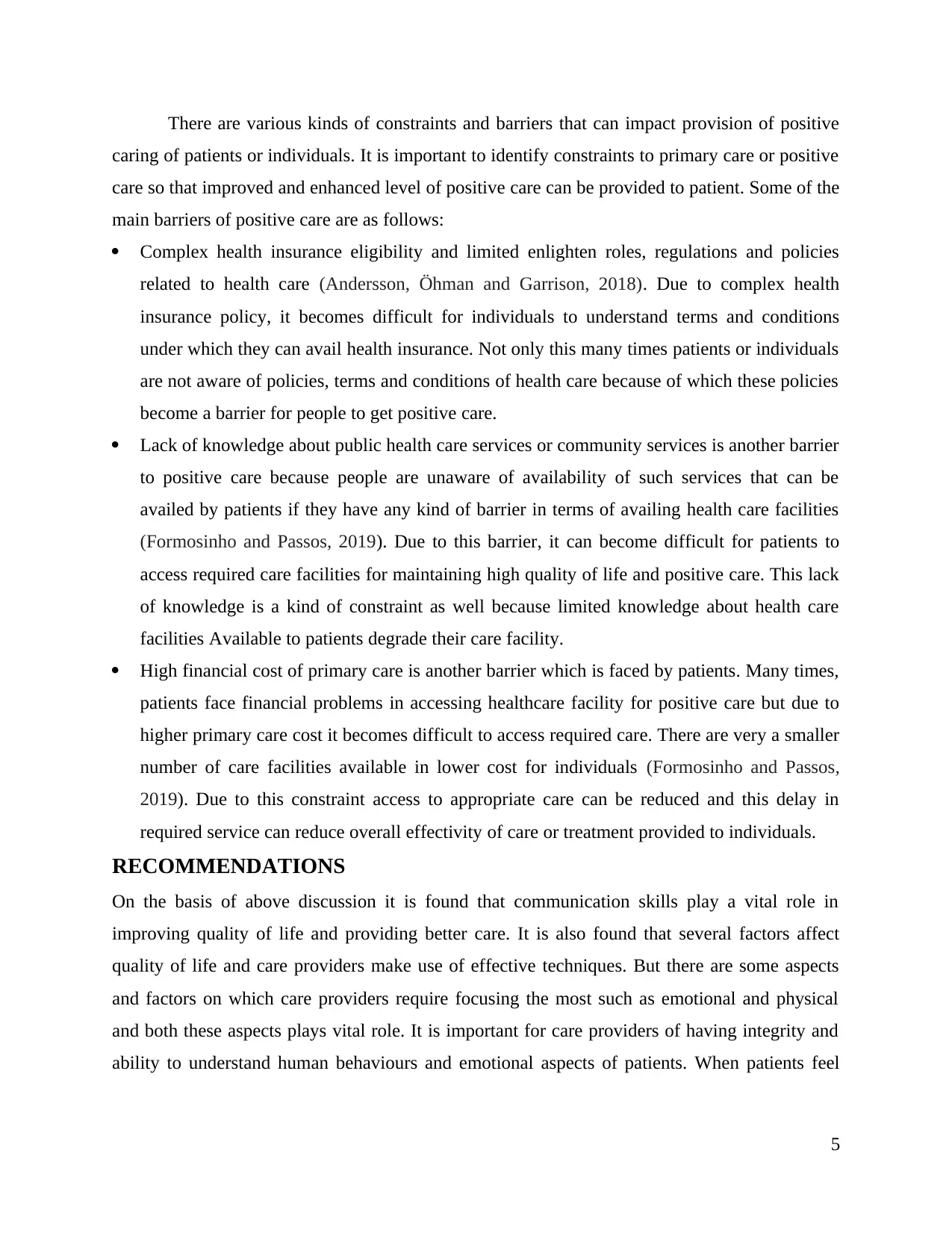
There are various kinds of constraints and barriers that can impact provision of positive
caring of patients or individuals. It is important to identify constraints to primary care or positive
care so that improved and enhanced level of positive care can be provided to patient. Some of the
main barriers of positive care are as follows:
Complex health insurance eligibility and limited enlighten roles, regulations and policies
related to health care (Andersson, Öhman and Garrison, 2018). Due to complex health
insurance policy, it becomes difficult for individuals to understand terms and conditions
under which they can avail health insurance. Not only this many times patients or individuals
are not aware of policies, terms and conditions of health care because of which these policies
become a barrier for people to get positive care.
Lack of knowledge about public health care services or community services is another barrier
to positive care because people are unaware of availability of such services that can be
availed by patients if they have any kind of barrier in terms of availing health care facilities
(Formosinho and Passos, 2019). Due to this barrier, it can become difficult for patients to
access required care facilities for maintaining high quality of life and positive care. This lack
of knowledge is a kind of constraint as well because limited knowledge about health care
facilities Available to patients degrade their care facility.
High financial cost of primary care is another barrier which is faced by patients. Many times,
patients face financial problems in accessing healthcare facility for positive care but due to
higher primary care cost it becomes difficult to access required care. There are very a smaller
number of care facilities available in lower cost for individuals (Formosinho and Passos,
2019). Due to this constraint access to appropriate care can be reduced and this delay in
required service can reduce overall effectivity of care or treatment provided to individuals.
RECOMMENDATIONS
On the basis of above discussion it is found that communication skills play a vital role in
improving quality of life and providing better care. It is also found that several factors affect
quality of life and care providers make use of effective techniques. But there are some aspects
and factors on which care providers require focusing the most such as emotional and physical
and both these aspects plays vital role. It is important for care providers of having integrity and
ability to understand human behaviours and emotional aspects of patients. When patients feel
5
caring of patients or individuals. It is important to identify constraints to primary care or positive
care so that improved and enhanced level of positive care can be provided to patient. Some of the
main barriers of positive care are as follows:
Complex health insurance eligibility and limited enlighten roles, regulations and policies
related to health care (Andersson, Öhman and Garrison, 2018). Due to complex health
insurance policy, it becomes difficult for individuals to understand terms and conditions
under which they can avail health insurance. Not only this many times patients or individuals
are not aware of policies, terms and conditions of health care because of which these policies
become a barrier for people to get positive care.
Lack of knowledge about public health care services or community services is another barrier
to positive care because people are unaware of availability of such services that can be
availed by patients if they have any kind of barrier in terms of availing health care facilities
(Formosinho and Passos, 2019). Due to this barrier, it can become difficult for patients to
access required care facilities for maintaining high quality of life and positive care. This lack
of knowledge is a kind of constraint as well because limited knowledge about health care
facilities Available to patients degrade their care facility.
High financial cost of primary care is another barrier which is faced by patients. Many times,
patients face financial problems in accessing healthcare facility for positive care but due to
higher primary care cost it becomes difficult to access required care. There are very a smaller
number of care facilities available in lower cost for individuals (Formosinho and Passos,
2019). Due to this constraint access to appropriate care can be reduced and this delay in
required service can reduce overall effectivity of care or treatment provided to individuals.
RECOMMENDATIONS
On the basis of above discussion it is found that communication skills play a vital role in
improving quality of life and providing better care. It is also found that several factors affect
quality of life and care providers make use of effective techniques. But there are some aspects
and factors on which care providers require focusing the most such as emotional and physical
and both these aspects plays vital role. It is important for care providers of having integrity and
ability to understand human behaviours and emotional aspects of patients. When patients feel
5
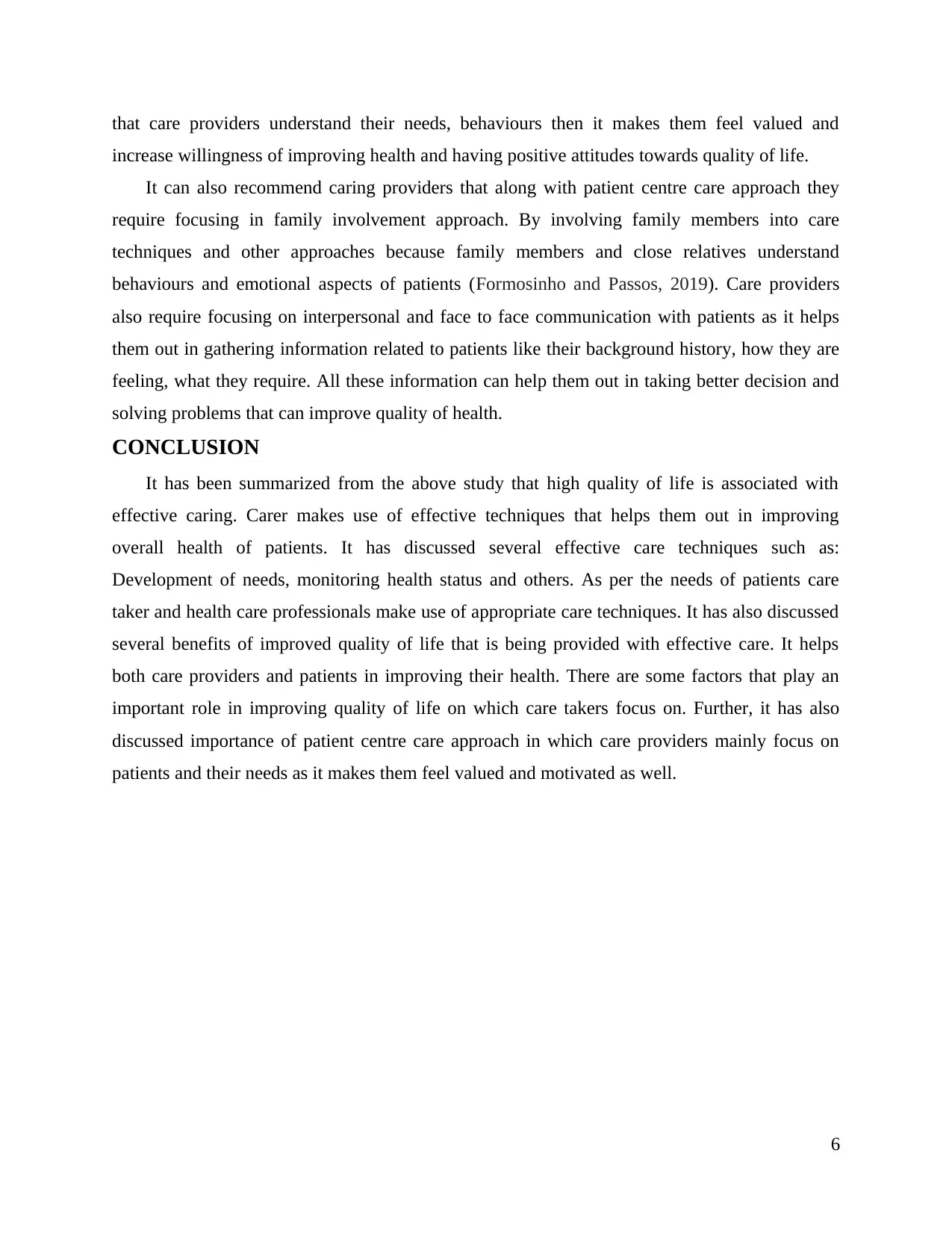
that care providers understand their needs, behaviours then it makes them feel valued and
increase willingness of improving health and having positive attitudes towards quality of life.
It can also recommend caring providers that along with patient centre care approach they
require focusing in family involvement approach. By involving family members into care
techniques and other approaches because family members and close relatives understand
behaviours and emotional aspects of patients (Formosinho and Passos, 2019). Care providers
also require focusing on interpersonal and face to face communication with patients as it helps
them out in gathering information related to patients like their background history, how they are
feeling, what they require. All these information can help them out in taking better decision and
solving problems that can improve quality of health.
CONCLUSION
It has been summarized from the above study that high quality of life is associated with
effective caring. Carer makes use of effective techniques that helps them out in improving
overall health of patients. It has discussed several effective care techniques such as:
Development of needs, monitoring health status and others. As per the needs of patients care
taker and health care professionals make use of appropriate care techniques. It has also discussed
several benefits of improved quality of life that is being provided with effective care. It helps
both care providers and patients in improving their health. There are some factors that play an
important role in improving quality of life on which care takers focus on. Further, it has also
discussed importance of patient centre care approach in which care providers mainly focus on
patients and their needs as it makes them feel valued and motivated as well.
6
increase willingness of improving health and having positive attitudes towards quality of life.
It can also recommend caring providers that along with patient centre care approach they
require focusing in family involvement approach. By involving family members into care
techniques and other approaches because family members and close relatives understand
behaviours and emotional aspects of patients (Formosinho and Passos, 2019). Care providers
also require focusing on interpersonal and face to face communication with patients as it helps
them out in gathering information related to patients like their background history, how they are
feeling, what they require. All these information can help them out in taking better decision and
solving problems that can improve quality of health.
CONCLUSION
It has been summarized from the above study that high quality of life is associated with
effective caring. Carer makes use of effective techniques that helps them out in improving
overall health of patients. It has discussed several effective care techniques such as:
Development of needs, monitoring health status and others. As per the needs of patients care
taker and health care professionals make use of appropriate care techniques. It has also discussed
several benefits of improved quality of life that is being provided with effective care. It helps
both care providers and patients in improving their health. There are some factors that play an
important role in improving quality of life on which care takers focus on. Further, it has also
discussed importance of patient centre care approach in which care providers mainly focus on
patients and their needs as it makes them feel valued and motivated as well.
6
⊘ This is a preview!⊘
Do you want full access?
Subscribe today to unlock all pages.

Trusted by 1+ million students worldwide
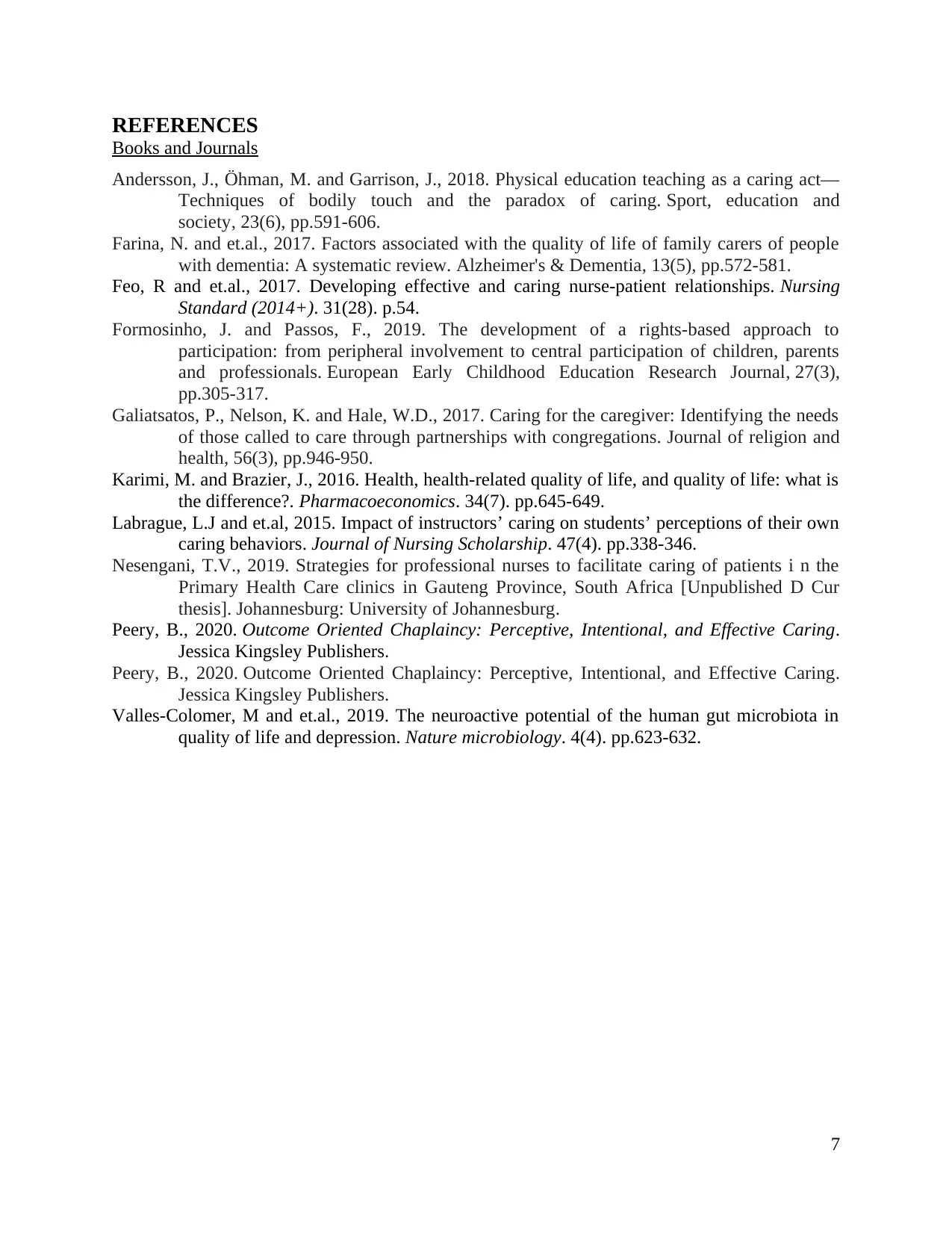
REFERENCES
Books and Journals
Andersson, J., Öhman, M. and Garrison, J., 2018. Physical education teaching as a caring act—
Techniques of bodily touch and the paradox of caring. Sport, education and
society, 23(6), pp.591-606.
Farina, N. and et.al., 2017. Factors associated with the quality of life of family carers of people
with dementia: A systematic review. Alzheimer's & Dementia, 13(5), pp.572-581.
Feo, R and et.al., 2017. Developing effective and caring nurse-patient relationships. Nursing
Standard (2014+). 31(28). p.54.
Formosinho, J. and Passos, F., 2019. The development of a rights-based approach to
participation: from peripheral involvement to central participation of children, parents
and professionals. European Early Childhood Education Research Journal, 27(3),
pp.305-317.
Galiatsatos, P., Nelson, K. and Hale, W.D., 2017. Caring for the caregiver: Identifying the needs
of those called to care through partnerships with congregations. Journal of religion and
health, 56(3), pp.946-950.
Karimi, M. and Brazier, J., 2016. Health, health-related quality of life, and quality of life: what is
the difference?. Pharmacoeconomics. 34(7). pp.645-649.
Labrague, L.J and et.al, 2015. Impact of instructors’ caring on students’ perceptions of their own
caring behaviors. Journal of Nursing Scholarship. 47(4). pp.338-346.
Nesengani, T.V., 2019. Strategies for professional nurses to facilitate caring of patients i n the
Primary Health Care clinics in Gauteng Province, South Africa [Unpublished D Cur
thesis]. Johannesburg: University of Johannesburg.
Peery, B., 2020. Outcome Oriented Chaplaincy: Perceptive, Intentional, and Effective Caring.
Jessica Kingsley Publishers.
Peery, B., 2020. Outcome Oriented Chaplaincy: Perceptive, Intentional, and Effective Caring.
Jessica Kingsley Publishers.
Valles-Colomer, M and et.al., 2019. The neuroactive potential of the human gut microbiota in
quality of life and depression. Nature microbiology. 4(4). pp.623-632.
7
Books and Journals
Andersson, J., Öhman, M. and Garrison, J., 2018. Physical education teaching as a caring act—
Techniques of bodily touch and the paradox of caring. Sport, education and
society, 23(6), pp.591-606.
Farina, N. and et.al., 2017. Factors associated with the quality of life of family carers of people
with dementia: A systematic review. Alzheimer's & Dementia, 13(5), pp.572-581.
Feo, R and et.al., 2017. Developing effective and caring nurse-patient relationships. Nursing
Standard (2014+). 31(28). p.54.
Formosinho, J. and Passos, F., 2019. The development of a rights-based approach to
participation: from peripheral involvement to central participation of children, parents
and professionals. European Early Childhood Education Research Journal, 27(3),
pp.305-317.
Galiatsatos, P., Nelson, K. and Hale, W.D., 2017. Caring for the caregiver: Identifying the needs
of those called to care through partnerships with congregations. Journal of religion and
health, 56(3), pp.946-950.
Karimi, M. and Brazier, J., 2016. Health, health-related quality of life, and quality of life: what is
the difference?. Pharmacoeconomics. 34(7). pp.645-649.
Labrague, L.J and et.al, 2015. Impact of instructors’ caring on students’ perceptions of their own
caring behaviors. Journal of Nursing Scholarship. 47(4). pp.338-346.
Nesengani, T.V., 2019. Strategies for professional nurses to facilitate caring of patients i n the
Primary Health Care clinics in Gauteng Province, South Africa [Unpublished D Cur
thesis]. Johannesburg: University of Johannesburg.
Peery, B., 2020. Outcome Oriented Chaplaincy: Perceptive, Intentional, and Effective Caring.
Jessica Kingsley Publishers.
Peery, B., 2020. Outcome Oriented Chaplaincy: Perceptive, Intentional, and Effective Caring.
Jessica Kingsley Publishers.
Valles-Colomer, M and et.al., 2019. The neuroactive potential of the human gut microbiota in
quality of life and depression. Nature microbiology. 4(4). pp.623-632.
7
1 out of 10
Related Documents
Your All-in-One AI-Powered Toolkit for Academic Success.
+13062052269
info@desklib.com
Available 24*7 on WhatsApp / Email
![[object Object]](/_next/static/media/star-bottom.7253800d.svg)
Unlock your academic potential
Copyright © 2020–2025 A2Z Services. All Rights Reserved. Developed and managed by ZUCOL.




